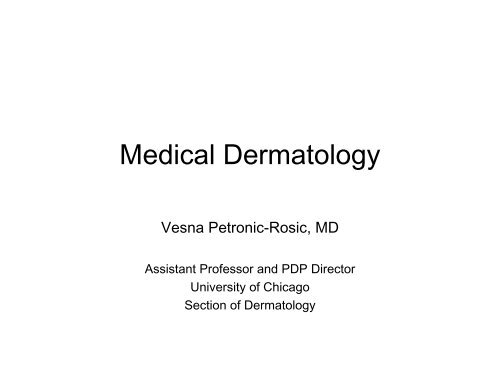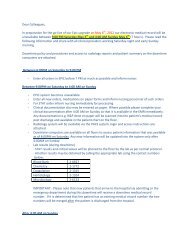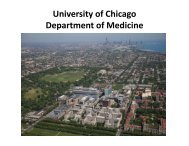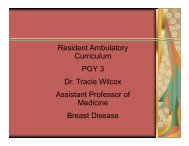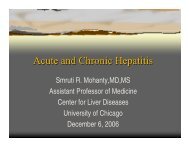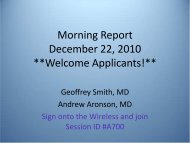9-25-06 Derm – Petronic-Rosic
9-25-06 Derm – Petronic-Rosic
9-25-06 Derm – Petronic-Rosic
Create successful ePaper yourself
Turn your PDF publications into a flip-book with our unique Google optimized e-Paper software.
Medical <strong>Derm</strong>atology<br />
Vesna <strong>Petronic</strong>-<strong>Rosic</strong>, MD<br />
Assistant Professor and PDP Director<br />
University of Chicago<br />
Section of <strong>Derm</strong>atology
Infections and Infestations
• Form of cellulitis with prominent<br />
lymphatic involvement<br />
• Etio:<br />
<strong>–</strong> Adults: Group A streptococcus<br />
and S. Aureus<br />
<strong>–</strong> Children: Haemophilus<br />
influenzae type B<br />
• More superficial with margins more<br />
clearly demarcated from normal<br />
skin than conventional cellulitis<br />
• Lower legs, face, and ears<br />
• Suspect H influenzae if TOXIC<br />
appearance<br />
Erysipelas
Recurrent episodes of<br />
infection result in lymphatic<br />
obstruction with permanent<br />
thickening of the skin<br />
Erysipelas<br />
Rx:<br />
• Cephalosporins or PNC<br />
• Rifampin prophylaxis<br />
<strong>–</strong> where the household includes<br />
a child in the susceptible age<br />
group (less than 4 years old)<br />
<strong>–</strong> in a day-care classroom where<br />
a case of systemic H.<br />
influenzae type B disease has<br />
occurred
• Etiol: group A betahemolytic<br />
streptococci or<br />
Staphylococcus aureus<br />
• RF: injury, stasis,<br />
lymphoedema, tinea pedis<br />
• PE: tender, deep red, and<br />
swollen<br />
• Dx: clinical, biopsy, tissue<br />
culture<br />
• Rx: cephalosporin<br />
Cellulitis
• Etiology: S. aureus - injury,<br />
abrasion, near surgical<br />
wounds or draining abscesses,<br />
may be a complication of<br />
occlusive topical steroid<br />
therapy<br />
• PE: follicular pustules with<br />
erythematous halo<br />
• Rx:<br />
<strong>–</strong> tepid, wet Burrow's compress<br />
<strong>–</strong> oral antibiotics<br />
Folliculitis
• Etiology : Pseudomonas<br />
from poorly maintained hot<br />
tubs / whirlpools<br />
Hot Tub Folliculitis<br />
• Clinical: small follicular,<br />
vesicular, pustular, or papular<br />
lesions occur a few hours to 5<br />
days after exposure, resolving<br />
in 7 to 10 days<br />
• Rx: needed only in severe<br />
cases - fluoroquinolones
Impetigo (Bullous/Nonbullous)<br />
• Etiology: Staph >Strep<br />
• Complications<br />
<strong>–</strong> Poststreptococcal<br />
glomerulonephritis may<br />
follow impetigo (10 days<br />
later): hematuria, edema<br />
• Will heal without Rx<br />
<strong>–</strong> Rheumatic Fever not a<br />
complication of impetigo<br />
• Rx: Bactroban ointment tid or<br />
Cephalosporin
Staphylococcal Scalded Skin Syndrome<br />
• Etio: S. aureus epidermolytic toxin<br />
in children < 5 y and in adults with<br />
renal insufficiency<br />
• 75% of children > 10y have the<br />
toxin AB<br />
• Renal function impaired: cannot<br />
clear toxin<br />
• Starts in flexures; + Nikolskiy sign<br />
• Dx: culture - nares, perianal,<br />
flexures<br />
• DDx: bullous impetigo<br />
• Rx: NO STEROIDS<br />
<strong>–</strong> Anti staph antibiotics
• Etio: Treponema pallidum<br />
• Transmission: sexual contact, in<br />
utero, and via blood transfusion<br />
Syphilis<br />
• Incubation 10-90 days: initial lesion of<br />
primary syphilis develops at the site of<br />
transmission, heals in 3-7 weeks<br />
• Chancre: single, painless papule that<br />
rapidly becomes eroded and indurated,<br />
ulcer has a cartilaginous consistency<br />
at the edge and base<br />
• High-risk groups include men having<br />
sex with men, inmates in correctional<br />
facilities, high-risk sexual activity
Secondary Syphilis<br />
• 4-10 weeks after primary lesion<br />
• <strong>Derm</strong>atitis-arthritis syndrome:<br />
malaise, fever, myalgias, and<br />
arthralgias + generalized body<br />
rash + lymphadenopathy<br />
• Immune reaction is at its peak<br />
and antibody titers are high<br />
• Rx for primary, secondary and<br />
early latent syphilis: benzathine<br />
penicillin 2.4 million U IM<br />
• Alternative treatments (14 d):<br />
doxycycline 100 mg PO bid,<br />
tetracycline 500 mg PO qid, or<br />
erythromycin 500 mg PO qid.<br />
• Penicillin-allergic patients should<br />
be desensitized in order to<br />
receive standard drug therapy
Late Syphilis<br />
• Chronic, progressive<br />
inflammatory process that<br />
produces clinical symptoms years<br />
to decades after initial infection<br />
<strong>–</strong> Gummatous<br />
<strong>–</strong> Neurosyphillis<br />
<strong>–</strong> Cardiovascular<br />
• Rx for late latent and tertiary:<br />
benzathine penicillin G 2.4 million<br />
U IM once weekly for 3<br />
consecutive weeks<br />
• Alternative treatments (4w):<br />
Doxycycline 100 mg PO bid or<br />
tetracycline 500 mg PO qid
Cutaneous Larva Migrans<br />
• Etiology: Ancylostoma braziliense<br />
• Random wandering of the hookworm<br />
larvae through the skin<br />
• Elevated tracks that change position<br />
and shape as the larvae migrate<br />
through the epidermis<br />
• Rx:<br />
<strong>–</strong> Topical application of thiabendazole<br />
is the treatment of choice<br />
<strong>–</strong> Albendazole #2<br />
<strong>–</strong> Do not freeze <strong>–</strong> may miss worm
• Etio: herpes simplex virus<br />
• Phases<br />
Herpes Simplex<br />
<strong>–</strong> primary phase, after which the<br />
virus becomes established in a<br />
nerve ganglion.<br />
<strong>–</strong> secondary phase,<br />
characterized by recurrent<br />
disease at the same site<br />
• Rx: acyclovir, famcyclovir,<br />
valacyclovir
Eczema Herpeticum<br />
(Kaposi Varicelliform Eruption)<br />
Atopic dermatitis, Darier’s disease, pemphigus, immunosuppressed
Herpes Zoster<br />
• Varicella zoster virus latent in dorsal<br />
root ganglion � single dermatome<br />
• 20% lifetime incidence, rarely recurs<br />
• Factors: age, immunosuppression,<br />
lymphoma, fatigue, stress, Rtg tx<br />
• May be the earliest clinical sign of HIV<br />
• Dx: Tzanck smear, biopsy,<br />
complement-fixation titer, DFA, culture<br />
• Rx: Acyclovir oral/Iv within 72 hrs<br />
• Postherpetic neuralgia: capsaicin,<br />
antidepressants, topical lidocaine,<br />
rhizotomy, emotional support
• Common, benign, usually<br />
asymptomatic, self-limited skin<br />
eruption<br />
• Etio: HHV-6 and -7<br />
• Phases<br />
Pityriasis Rosea<br />
I: 2-10 cm oval lesion (herald<br />
patch)<br />
II: The fully evolved eruption 2<br />
weeks after onset
• Ring of scale (collarette scale)<br />
• Christmas tree pattern on back<br />
• No systemic symptoms<br />
• Dx: clinical, biopsy<br />
• DDx: tinea, secondary syphilis,<br />
psoriasis and nummular<br />
dermatitis<br />
• Rx: topical & PO steroids,<br />
Benadryl, sun exposure, UVB<br />
Pityriasis Rosea
Molluscum Contagiosum<br />
• DNA poxvirus infection in<br />
children and adults<br />
• Transmission by direct skin<br />
contact and autoinoculation<br />
• Incubation: 14-50 days<br />
• Firm, smooth, umbilicated 2-6 mm<br />
papules in groups or widely<br />
disseminated on the skin and<br />
mucosal surfaces; > 15 mm in HIV<br />
• Self-limited but can persist for<br />
several years<br />
• Rx: cantharidin, tretinoin,<br />
podophyllin, TCA, AgNo3 , LN2
• Etio: Trichophyton (T. rubrum),<br />
Microsporum, Epidermophyton<br />
Tinea Corporis<br />
• Clinical: annular,erythematous,<br />
papulosquamous lesion that may<br />
grow rapidly, with vesicular edge<br />
• Dx: KOH and culture<br />
• Rx:<br />
<strong>–</strong> topical: azoles, allylamines<br />
<strong>–</strong> systemic: griseofulvin,<br />
itraconazole, terbinafine
• Etio: Malassezia furfur<br />
• Clinical: hypopigmented or<br />
hyperpigmented macules and<br />
patches on chest and back<br />
• Chronically recurrent<br />
• Dx: clinical, Woods light, KOH<br />
• Rx:<br />
<strong>–</strong> topical: antifungals, selenium<br />
sulfide,<br />
<strong>–</strong> systemic: ketoconazole,<br />
itraconazole, fluconazole<br />
Tinea Versicolor
• Etio: Borrelia burgdorferi<br />
• Vector: deer tick<br />
• Stages<br />
1. EM + flu like Sx<br />
2. Cardiac/Neuro Disease<br />
Lyme Disease<br />
3. Arthritis and chronic neurological<br />
symptoms<br />
• Dx: PCR most sensitive<br />
• Rx: doxycycline or amoxicillin<br />
• DEET repellant for prophylaxis
• Etio: Sarcoptes scabiei<br />
• Clinical<br />
<strong>–</strong> burrow in the web space<br />
<strong>–</strong> inflammatory papules<br />
<strong>–</strong> nocturnal pruritis<br />
• Dx: clinical, scabies prep, bx<br />
• Rx<br />
<strong>–</strong> permethrin (92%)<br />
<strong>–</strong> lindane (86%) ?neurotoxic<br />
<strong>–</strong> sulfur<br />
<strong>–</strong> ivermectin<br />
Scabies
Scabies<br />
Pustules on the palm and<br />
papular lesions on the wrist<br />
are typical in infants<br />
Eroded papules on the glans are a<br />
highly characteristic sign of scabies;<br />
large papules may remain after<br />
appropriate therapy and sometimes<br />
require treatment with intralesional<br />
steroids (noduli scabiei)
Treat the entire family!
Lice<br />
• Pediculus humanus<br />
• Transmission: close contact, fomites, overcrowding encourages spread<br />
• The body louse is the vector of typhus, trench fever, and relapsing fever.<br />
• Clinical: itching � scratching � inflammation and sec bacterial infection<br />
• Dx: clinical, Wood’s light<br />
• Rx: permethrin, lindane, combing with vinegar solution; treat family
Immunologically Mediated Diseases
Bullous Pemphigoid<br />
• Etiol: autoimmune blistering disease<br />
• IgG autoantibodies: circulating and bound in the lamina lucida region of BMZ<br />
• Complement is activated � chemotaxis and degranulation of leukocytes,<br />
release of proteolytic enzymes � basement membrane destruction resulting in<br />
dermal-epidermal separation: subepidermal blister
Bullous Pemphigoid<br />
• No race/sex preference<br />
• Usually > 60 y<br />
• Bullae good structural integrity, in<br />
contrast to the large, flaccid, easily<br />
ruptured bullae of pemphigus<br />
• Nikolskiy's sign is negative<br />
• Generally heal without problems<br />
• Rx:<br />
<strong>–</strong> itching: hydroxyzine<br />
<strong>–</strong> antibiotics (tetracycline)<br />
<strong>–</strong> systemic steroids<br />
<strong>–</strong> immunosuppressive agents:<br />
azathioprine, cyclophosphamide,<br />
methotrexate, or chlorambucil
Pemphigus Vulgaris<br />
• Autoimmune intraepidermal blistering<br />
disease of skin and mucous<br />
membranes<br />
• Circulating IgG autoantibodies directed<br />
against desmosomal proteins<br />
• Oral erosions commonly occur and may<br />
precede the onset of skin blisters by<br />
weeks or months<br />
• Flaccid blisters, + Nikolskiy sign<br />
• Exposed erosions last for weeks before<br />
healing with hyperpigmentation<br />
• Death used to be 10% from<br />
complications of steroid therapy
• Dx: biopsy for H&E and DIF<br />
• Rx:<br />
Pemphigus Vulgaris<br />
<strong>–</strong> steroids<br />
<strong>–</strong> adjuvant (steroid-sparing) therapy:<br />
mycophenolate mofetil, cyclophosphamide,<br />
chlorambucil, azathioprine, dapsone, Cs,<br />
gold, plasma exchange, ECP, IvIg<br />
• Associations: myasthenia gravis and<br />
thymoma<br />
<strong>–</strong> most patients develop myasthenia gravis,<br />
followed by the detection of thymus<br />
disease, and finally by pemphigus<br />
<strong>–</strong> malignancy (lymphoid or RES) more<br />
frequently than in healthy controls
Erythema Nodosum<br />
• Hypersensitivity reaction to a<br />
variety of antigenic stimuli<br />
• Associations<br />
<strong>–</strong> diseases: strep, sarcoidosis,<br />
Hodgkin’s disease<br />
<strong>–</strong> drugs: halides, sulfonamides, OCP<br />
<strong>–</strong> pregnancy<br />
• 50% of cases are idiopathic<br />
• F>M<br />
• Nonspecific systemic illness with<br />
low-grade fever, malaise,<br />
arthralgias, and arthritis<br />
• Self-limited: symptomatic relief,<br />
SSKI, steroids, NSAIDs
Lupus erythematosus - Discoid<br />
• Autoimmune disease<br />
• F > M<br />
• RF: UV exposure, trauma<br />
• Clinical signs<br />
<strong>–</strong> alopecia<br />
<strong>–</strong> atrophy<br />
<strong>–</strong> telangectasies<br />
<strong>–</strong> urticaria<br />
<strong>–</strong> Raynaud’s syndrome<br />
<strong>–</strong> vasculitis
Lupus Erythematosus<br />
Clinical Workup<br />
<strong>–</strong> biopsy for histology and DIF<br />
<strong>–</strong> system review<br />
<strong>–</strong> ANA, anti-dsDNA, anti- Ro/La<br />
<strong>–</strong> urinalysis<br />
<strong>–</strong> ESR, CBC<br />
<strong>–</strong> C3, C4, CH50<br />
Therapy<br />
<strong>–</strong> sunscreens<br />
<strong>–</strong> topical/intralesional/systemic steroids<br />
<strong>–</strong> anti-malarial drugs<br />
<strong>–</strong> dapsone<br />
<strong>–</strong> other<br />
• azathioprine<br />
• thalidomide<br />
• acitretin is effective for severe,<br />
chloroquine-resistant DLE
• Idiopathic inflammatory myopathy with<br />
characteristic cutaneous findings<br />
• Frequently affects joints, esophagus,<br />
lungs, and, less commonly, heart<br />
• Females 50-60 yo, W>B<br />
• Clin: Heliotrope rash + Gottron papules +<br />
proximal symmetrical muscle weakness<br />
• Malar erythema, poikiloderma, violaceous<br />
erythema on extensor surfaces,<br />
periungual changes<br />
• Dx: CK, ANA, anti-Mi-2, anti-Jo-1, anti-Ku<br />
• Tx:<br />
<strong>–</strong> steroids<br />
<strong>–</strong> immunosupressive/cytotoxic drugs<br />
<strong>–</strong> IvIg<br />
<strong>–</strong> antimalarial drugs<br />
<strong>–</strong> phototprotection<br />
<strong>Derm</strong>atomyositis
• Systemic connective tissue disease<br />
<strong>–</strong> Essential vasomotor disturbances<br />
<strong>–</strong> Fibrosis<br />
<strong>–</strong> Subsequent atrophy of the skin, subcutaneous<br />
tissue, muscles, and internal organs<br />
<strong>–</strong> Immunologic disturbances<br />
• Females 30-40 yo<br />
• Clin: pruritus, Raynaud, difficulty swallowing,<br />
SOB, palpitations, cough, arthralgia, weakness<br />
• Dx: 1 major + 2 minor<br />
Systemic Sclerosis<br />
<strong>–</strong> Major features: centrally located skin sclerosis that<br />
affects the arms, face, and/or neck<br />
<strong>–</strong> Minor features: sclerodactyly, erosions, atrophy of<br />
the fingertips, and bilateral lung fibrosis<br />
<strong>–</strong> ANAs: anti-topoisomerase I DNA (Scl 70),<br />
anticentromere<br />
• Tx: organ specific +<br />
<strong>–</strong> D-penicillamine<br />
<strong>–</strong> Interferon alfa and interferon gamma<br />
<strong>–</strong> Immunomodulatory agents
Drug Induced <strong>Derm</strong>atoses
Fixed Drug Eruption<br />
• Lesions recur in the same area<br />
when the offending drug is given<br />
• PE: circular, violaceous,<br />
edematous plaques that resolve<br />
with macular hyperpigmentation<br />
• Lesions occur 30 m to 8 hrs after<br />
drug administration<br />
• Hands, feet, and genitalia<br />
• Acetaminophen, ampicillin,<br />
anticonvulsants, aspirin/NSAIDs,<br />
phenacetin, phenolphthalein,<br />
sulfonamides, tetracyclines
Urticaria<br />
• PE: Small wheals that may coalesce or<br />
have cyclical or gyrate forms<br />
• Lesions appear shortly after start of<br />
drug therapy and resolve rapidly when<br />
drug is withdrawn<br />
• Dx: clinical<br />
• DDX: giant urticaria may resemble EM<br />
• Etio: ACE-inhibitors, aspirin/NSAIDs,<br />
blood products, cephalosporins,<br />
infliximab, opiates, penicillin, radiologic<br />
contrast material, tetracycline,<br />
vaccines, and zidovudine
Henoch-Schoenlein Purpura<br />
• Acute IgA<strong>–</strong>mediated<br />
leukocytoclastic vasculitis that<br />
affects primarily children<br />
• Etiology<br />
<strong>–</strong> allergens<br />
<strong>–</strong> infections: mono, strep<br />
<strong>–</strong> vaccines<br />
<strong>–</strong> drugs: ampicillin, erythromycin,<br />
penicillin, quinidine, quinine<br />
• Purpura, arthritis, abdominal pain, GI<br />
bleeding, orchitis, and nephritis<br />
• Dx: biopsy and DIF<br />
• Rx: admit for monitoring of abdominal<br />
and renal complications, steroids prn
Erythema Multiforme<br />
Etiol: unknown in 50% cases<br />
Associations :<br />
Herpes simplex (HSAEM),<br />
Mycoplasma infection, primary<br />
atypical pneumonia<br />
Clinical: target lesions on acral<br />
sites<br />
Rx<br />
• steroids<br />
• acyclovir may prevent herpes<br />
recurrence<br />
<strong>–</strong> no help once herpes occurs or to<br />
prevent EM from occurring
Stevens Johnson Syndrome<br />
• Vesiculobullous disease of the<br />
skin, mouth, eyes, and genitals<br />
• Drugs most common cause:<br />
phenytoin, phenobarbital,<br />
sulfonamides, penicillins<br />
• Dx: clinical, biopsy<br />
• Rx:<br />
<strong>–</strong> steroids<br />
<strong>–</strong> antihistamines<br />
<strong>–</strong> IvIg
Toxic Epidermal Necrolysis (TEN)<br />
• Full-thickness loss of the epidermis<br />
results in a mortality of <strong>25</strong>% to 100%<br />
• Death is usually caused by<br />
overwhelming sepsis<br />
• Etiol: drugs (not related to dose)<br />
• Seen in HIV pts due to sulfa<br />
• Dx: clinical, frozen sections, bx<br />
Drugs most commonly involved:<br />
• Phenytoin<br />
• Phenobarbital<br />
• Carbamazepine<br />
• Sulfonamides<br />
• Ampicillin<br />
• Allopurinol<br />
• Antituberculous drugs<br />
• Thiacetazone<br />
• Isoniazid<br />
• NSAIDs
Symptoms<br />
TEN<br />
<strong>–</strong> Mucosal involvement: inflammation,<br />
blistering, and erosion, especially<br />
oropharynx, are early and<br />
characteristic<br />
<strong>–</strong> Pneumonia: 40% pts<br />
<strong>–</strong> Eye findings common<br />
Rx: conservative<br />
conjunctival erosions with<br />
subsequent revascularization,<br />
fibrous adhesions, and corneal<br />
ulceration<br />
<strong>–</strong> burn unit<br />
<strong>–</strong> keep clean, dry<br />
<strong>–</strong> no steroids<br />
<strong>–</strong> IvIg
Neoplasms
• Risk Factors<br />
Basal Cell Carcinoma<br />
<strong>–</strong> fair skin + sun exposure (UVA & B)<br />
• Location: Head/neck<br />
• Locally invasive, rarely metastasize<br />
• Rx: surgical excision, radiation
Squamous Cell Carcinoma<br />
• AGGRESSIVE<br />
<strong>–</strong> Prior radiation<br />
<strong>–</strong> Thermal injury<br />
<strong>–</strong> Chronic draining sinuses<br />
<strong>–</strong> Chronic ulcers<br />
<strong>–</strong> Immunosuppression<br />
• Renal Transplant pts<br />
• NON AGGRESSIVE<br />
<strong>–</strong> Sun exposure<br />
• Rx: surgical excision
Keratoacanthomas vs. SCC<br />
Keratoacanthoma<br />
<strong>–</strong> Grow rapidly, then regress<br />
<strong>–</strong> Smooth surface (compared to<br />
SCC)<br />
<strong>–</strong> Red papule that develops<br />
keratotic plug<br />
<strong>–</strong> Not associated with internal<br />
malignancy<br />
Rx: electrodesiccation and curettage, surgical excision<br />
<strong>–</strong> Intralesional: 5-FU , MTX
Malignant Melanoma<br />
• Etiol: environmental, genetic<br />
• RF<br />
<strong>–</strong> excessive sun exposure (esp<br />
UVA)<br />
<strong>–</strong> alterations of the upper<br />
atmosphere by pollutants<br />
resulting in increased radiation<br />
<strong>–</strong> white > black<br />
• Prevention<br />
<strong>–</strong> stay out of sun<br />
<strong>–</strong> sunscreen<br />
<strong>–</strong> frequent skin exams
Physical Exam<br />
• Asymmetry<br />
Malignant Melanoma<br />
• Border irregularity<br />
• Color variegation<br />
• Diameter enlargement<br />
Poor Prognostic Factors<br />
<strong>–</strong> vertical growth phase (mm)<br />
<strong>–</strong> ulceration<br />
<strong>–</strong> high mitotic index<br />
<strong>–</strong> marked cytologic atypia<br />
<strong>–</strong> minimal tumor inflammatory ly<br />
<strong>–</strong> presence of regression<br />
<strong>–</strong> presence of plasma cells<br />
<strong>–</strong> male sex<br />
<strong>–</strong> age > 45 years<br />
<strong>–</strong> axial anatomic location
Miscellaneous
Insect Bite Reaction<br />
• Intensely pruritic commonly excoriated<br />
papules grouped where the bites occur<br />
<strong>–</strong> linear arrangement of 3 bites in a row is<br />
often a sign of bedbug (Cimex) bites;<br />
head and neck<br />
<strong>–</strong> flea bites usually occur on the legs<br />
• Vesicular and bullous reactions and<br />
pseudolymphomatous nodules may<br />
occur<br />
• Dx: clinical, biopsy<br />
• Rx: topical steroids, anesthetics,<br />
antipruritics<br />
• Repellent!<br />
• Vectors for disease
Miliaria<br />
• Disorder of the eccrine sweat<br />
glands<br />
• Heat and humidity � blockage of<br />
sweat ducts� leakage of sweat<br />
into the epidermis/dermis:<br />
<strong>–</strong> crystallina<br />
<strong>–</strong> profunda<br />
<strong>–</strong> rubra: tropics; heat exhaustion<br />
• Dx: clinical<br />
• Rx: cooling, showers, anhydrous<br />
lanolin for miliaria profunda, limit<br />
activity
Seborrheic <strong>Derm</strong>atitis<br />
PE: fine, dry, white or yellow scale with<br />
minor itching<br />
Associations: Parkinson’s, HIV, CNS<br />
disorders<br />
TREATMENT<br />
• Frequent washing of all affected<br />
areas with an antidandruff shampoo<br />
• Group V topical steroid creams<br />
• Ketoconazole<br />
• Zinc soaps or selenium lotions<br />
suppress activity, maintain remission
Psoriasis<br />
Clinical: red plaques with silvery<br />
scale on extensor surfaces, nail<br />
pitting, arthritis<br />
Etiology: genetic, drugs, infection<br />
(strep)<br />
Dx: clinical, biopsy<br />
DRUGS causing/worsening psoriasis<br />
<strong>–</strong> lithium<br />
<strong>–</strong> antimalarials<br />
<strong>–</strong> beta blockers<br />
<strong>–</strong> steroids
Psoriasis <strong>–</strong> Therapy<br />
• Localized lesions<br />
<strong>–</strong> injections in the plaque with steroids<br />
• Generalized lesions<br />
<strong>–</strong> topical steroids<br />
<strong>–</strong> calcipotriol (Dovonex) - vitamin D3 analogue inhibits<br />
epidermal cell proliferation and enhances cell differentiation<br />
<strong>–</strong> anthralin: chronic plaques (and in combination with UVB)<br />
<strong>–</strong> UVB (+ tar), PUVA, methotrexate, etretinate, and cyclosporine<br />
• Guttate psoriasis<br />
<strong>–</strong> antibiotics and UVB
Thank you!


